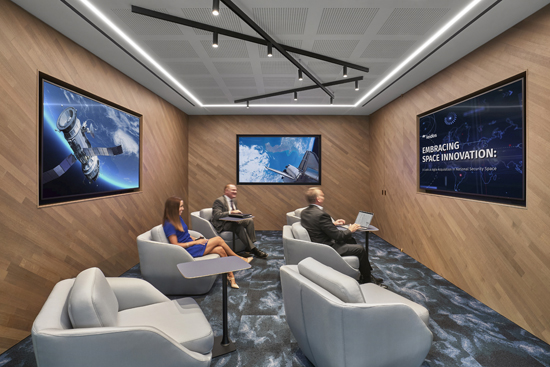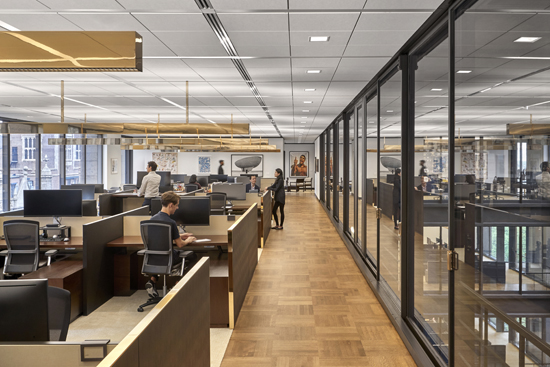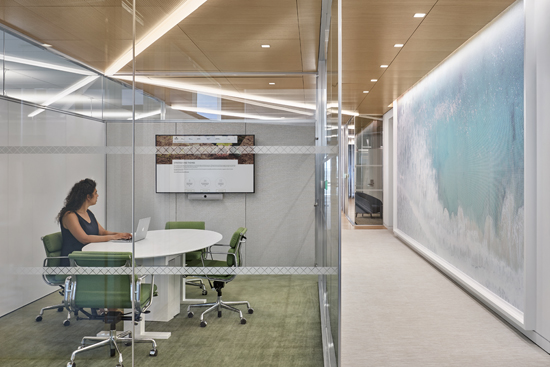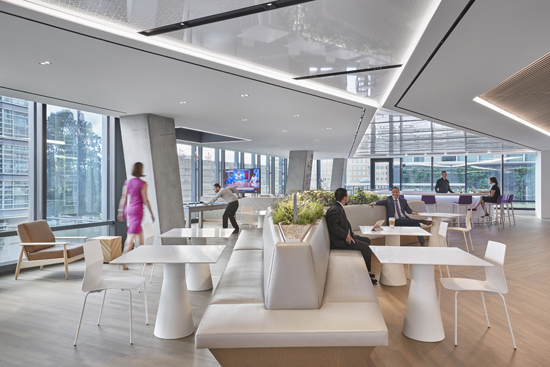The Science of Sound: Building Science Experts Reveal
Common Pitfalls in CRE Environments
The built environment can be a noisy place, frequently subjecting people to unwelcome sounds. Noise from interior and exterior sources—in the workplace and at home—negatively impact hearing and diminish productivity. Working from home, a trend that blossomed during the COVID-19 pandemic, exposed people to a wide array of “new” disruptive sounds. Without proper planning and management, poor acoustics can create unwanted intrusions or make people avoid spaces altogether.
More than ever, developers and building owners are striving to create attractive, productive environments that are healthier for occupants. Interior environments must be safeguarded against sound levels that would impact a person’s ability to hear. Most, however, don’t take into consideration how excessive levels of less damaging but costlier everyday noise affect the ability to concentrate, learn, rest, and heal. Such factors also amplify stress levels.
For example, a study by the Danish Cancer Society monitoring the effect of traffic noise found that for every 10-decibel increase, the risk of heart attack went up 12 percent - with increases in risk starting at only 40dB.
Yet, as developers seek to create productive environments that are also healthier for occupants, modern properties can unintentionally produce a mix of noises from the uses, amenities, or surrounding environments – all of which can add up to a space that is less productive and less healthy.
Controlling, mitigating, and eliminating noise requires experts in the design, materials, and physics of sound. Such specialists can preview plans and designs, evaluate the acoustics in a space, trace the source, and determine the best way to help manage the impact of those sounds.
In this first of a two-part Unintended Consequences of Sound series we’ll consider the science of sound in the built environment through the ears and experience of Saint-Gobain experts Stan Gatland, Manager Building Science and Comfort, and Lucas Hamilton, Manager Applied Building Science. The second part will cover acoustic comfort in projects that, in the COVID-19 era, find more people working in home soundscapes and mixed-use environments.

Aspects of Sound
 Sound surrounds each of us, constantly bathing us in a chorus of what is either considered a soothing and pleasant realm or assaulting us with a cacophony of unwanted and disturbing annoyances. We never experience absolute quiet, even while sleeping. Engineers work to understand and control the impact of sound in built environments.
Sound surrounds each of us, constantly bathing us in a chorus of what is either considered a soothing and pleasant realm or assaulting us with a cacophony of unwanted and disturbing annoyances. We never experience absolute quiet, even while sleeping. Engineers work to understand and control the impact of sound in built environments.
These sound scientists must continue to share their knowledge and engage owners, developers, and designers in important soundscape design details so that such findings eventually make their way into real-world settings from office buildings, and hotels, to retail centers, or apartment complexes.
Experts know sound waves travel through air creating very small changes in atmospheric pressure. The sensation of hearing, produced by vibrating the eardrum, is attributable to these slight pressure changes.
“In a general sense, sound isn’t intuitive to people in the way it travels, emanating from a source like a bubble within a bubble into space,” says Gatland. “There is a difference in how sound is heard, received, and perceived between ages, genders, and cultures. Often what is considered an annoying noise to one person may be embraced by another. Our role is to apply science to sound and interpret it in order to make its impacts better understood by our commercial real estate clients.”
Sound waves can travel through any substance, including air, water, wood, masonry or metal. The type of substance determines whether the sound is either airborne or structure-borne. Airborne sound is directly transmitted from a source into the air. Except for the sound of your own voice, all sound that reaches your ear is airborne. Examples include passing traffic, music or voices from an adjacent room, or the noise from machinery and aircraft.
Structure-borne sound travels through solid materials, either from direct contact with the sound source or from an impact on the material. Since what we interpret as sound derives from the vibration of our eardrum and three small bones in each inner-ear, all structure-borne sound must eventually become airborne sound in order for people to hear it. Examples of structure-borne noise include footsteps, door slams, plumbing vibrations, mechanical vibrations, and rain impact.
Most noise control situations require the consideration of both airborne and structure-borne sound. Effective sound control addresses both sound paths by controlling or reducing noise at the source, reducing paths or blocking noise along its path, or shielding the receiver from the noise.
Balancing Space and Purpose
Sound sources take every available path to reach the receiver, but there are ways to mitigate this in indoor and outdoor settings. “The goal is to create an environment that people naturally like for the intended purpose,” says Gatland. “That tends to result in a better experience, helps reduce occupant stress, and leads to better health and well-being.”
Creating quiet, undisturbed spaces isn’t always possible nor is it always the goal. In fact, noise isn’t always negative. It can benefit the space and, in some cases, can be a solution.. “Sometimes noise is your friend,” says Hamilton. “It can be a component of creating privacy. For instance, when it is used to control how far voices travel.”



In restaurants, a large empty space can be negatively impacted by loud noises, but the right sound can create an enjoyable atmosphere for lunch. A “blanket of sound” can be used to create an environment that mutes conversations so an entire restaurant or open office floor doesn’t hear them, points out Hamilton.
Noise can be used to create the ambience and vibe a restaurant is striving to achieve, whether a fine dining experience or a more lively and dynamic space that appeals to a different audience. Sound scientists understand how to create an atmosphere based on the desired outcome. Office settings are prime examples of how the intended soundscape for specific spaces must be carefully weighed and balanced. Designers must consider if the space is being used for private work tasks, as a collaborative area with open plan workstations, or if it is a transition space.
“Each of those scenarios requires us to deal with having enough absorption to minimize the reflection,” notes Gatland. “Space should be separated so activity in that space doesn’t impact an adjacent space, and the space should be configured so the activities within it do not overlap.”
 Finding Solutions
Finding Solutions
 Passive solutions focused on absorbing and blocking are always the first step to reduce sound paths, such as partitions that mitigate sound transmission. Or measures could be taken to quiet a noisy HVAC system by dampening or isolating various elements. In big open spaces, it’s often necessary to raise background white noise to create privacy for conversations. Sound engineers have found that it is ideal for voices to fall off and blend into background noise at six to 12 feet away from a desk.
Passive solutions focused on absorbing and blocking are always the first step to reduce sound paths, such as partitions that mitigate sound transmission. Or measures could be taken to quiet a noisy HVAC system by dampening or isolating various elements. In big open spaces, it’s often necessary to raise background white noise to create privacy for conversations. Sound engineers have found that it is ideal for voices to fall off and blend into background noise at six to 12 feet away from a desk.
But with so many elements at play, creating the perfect balance requires sound scientists to consider absorption factors as well as reducing the reach of disruptive voices by introducing “white noise” into key locations.
Sound finds the path of least resistance through ducts, pipes, or holes, which can work against an owner’s investment and the measures designed to moderate or reduce sound. “We often find ‘cross talk’ through HVAC systems and people in other rooms or on different floors can often hear conversations,” says Gatland. “If the construction process did not result in a good job of air sealing a space, it creates an airflow path for sound and thermal energy into indoor environments.”
But in other environments, sound is intended to be carried directly to people. Think of training and large conference rooms or auditoriums. That’s one reason movie theaters are designed to simulate an open field of grass. Sound travels unabated with minimal reflection to audiences. Sound is directed to people who are surrounded by soft surfaces that help keep reflective qualities low and allow clean sound to arrive at the ears of moviegoers.
Reducing Noise
The best mitigation methods start with design and the selection of building materials that can be used to mitigate sound more effectively. Acoustic disturbances are often created in office transition zones where one area intersects with another. This is especially difficult to manage when it involves hard surfaces or open plans, such as areas near the lobby, near elevators, collaboration spaces, or even small meeting areas not designed with acoustics in mind. Even with absorptive wall panels and other sound-masking efforts, conversations can carry farther simply because the path was surrounded by materials such as glass, tile, and other hard surfaces that may have been created for aesthetic and maintenance issues. The sound problem may manifest in many ways and can be helped through multiple ideas to identify the problem and craft a solution.
Perhaps one of the most important factors in reducing unwanted sound are the methods utilized to build partitions, notes Gatland. He points out the value of structural isolation practices where suspended systems and Z-shaped channels help keep elements separated between ceilings and walls. In combination with proper insulation, sound can be minimized because the elements are floating rather than attached. Building scientists know doing so can dramatically reduce air and structure-borne sound transmission.
“The initial additive measures taken may each be small in budget and effort, but the impact adds up to a larger noise decrease since sound isn’t a linear equation,” says Hamilton. “It is a process in which two-plus-two may equal six because the more you do to mitigate sound, the more you can accomplish.”
Occupant needs help determine the measures designers and acousticians may suggest to improve a space. In an office building the experts first examine if there is sufficient sound absorption. What acousticians call reverberation time is the amount of time a specific volume of sound takes to dissipate in a given space.
“Lower numbers are better, and we work to follow the owner’s requirements based on what the space is being used for,” says Hamilton. “We start there and then look at all surfaces and assemblies to see what we can do to improve a space from a sound perspective.”
That typically means looking at the ceiling. In situations with chopped up workspaces, the desk partitions with soft surfaces or carpeting can be used to absorb sound too. Another place to incorporate noise reduction solutions could be between meeting rooms or large spaces, where partitions can make a difference. For example, challenging mechanical room noise reaching other spaces can be reduced with double steel, staggered stud walls, or specialty drywall. Ultimately, the best sound reduction results will come from a combination of efforts.
Human Factor
Often the people component is overlooked when designing the aesthetic aspect of a building. When buildings are designed without sound in mind it can create spaces that are uncomfortable. The space may look great but if it’s unused—that is wasted square footage.
This has become an even more important factor today as companies strive to attract and retain talent. Employers must deliver environments that enhance productivity while, at the same time, provide comfort from a visual and sound perspective.
If people are used to being in loud spaces, sound may not be as much of an issue. Some team cultures are built to flourish in a noisy environment, thus the space may not need to be over-engineered. Yet, for most, creating a workspace that fosters productivity and reduces stress means moderating and balancing acoustics to more competitive levels.
CRE owners and developers cannot underestimate the impact of acoustics on the experience and value of their investments, and they must understand and mitigate sound impact in built environments to create the most desirable and appealing settings.
The second part in this series will follow how Saint-Gobain’s sound experts approach acoustic comfort in commercial projects and balance sound within the context of a project’s aesthetic aspirations.
 SAINT-GOBAIN main website
SAINT-GOBAIN main website
